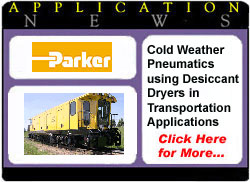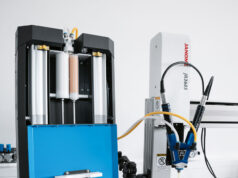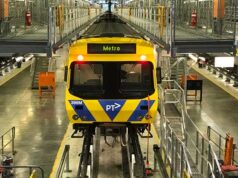 by
by
Paxton Augustine
Product Manager – Transportation
Parker Hannifin Corporation
and
Randy Greenwood
Account Development Manager – Railway and Transportation
domnick hunter Division of Parker Hannifin
Pneumatic cylinders, valves, and auxiliary products are used in multiple subsystems for truck, bus, and rail applications. Whether used for HVAC, door controls, brake lines, auxiliary panels, or chassis, pneumatic components must be able to operate in cold weather environments, in temperatures sometimes as low as -40 (F).
Many manufacturers of pneumatic cylinders and valves provide products built to function in this demanding temperature range. The fact remains that, no dryer system or a poorly maintained dryer system in this environment will lead to failing components whether they are designed for cold temperatures or not.
Without an adequate dryer system, moisture will form in the pneumatic system’s lines and, as the temperature falls below freezing, ice crystals will begin to form in the system, resulting in premature failure. In addition to ice crystals forming in the compressed air system, another ill effect of water in the system is the washing away of pre-lubricants on cylinders and valves, decreasing their operational life.
The common need then for cold weather pneumatic applications among all three segments of the transportation industry – truck/trailer, bus, and rail – is an adequate dryer system that is well maintained and serviced to eliminate moisture and prevent freezing in the air system. A desiccant dryer system is most suited for these applications.

Desiccant Dryer Systems
Desiccant (Adsorption) dryers pass air over a regenerative absorbent material and remove liquid from the compressed air system through the use of chemical beds. There are two types of desiccant dryer systems commonly used in transportation applications – single tower systems and twin tower systems. Both perform the job of removing water from the system, but some key differences make one style more advantageous over the other, depending upon the application. The differences are size, cost, and the amount of required service to maintain the system.
Both single and twin tower desiccant dryers operate on the same basic principle of pressure-swing-cycle adsorption and desorption of water vapor from the compressed air stream. The difference between the two designs is that a twin tower dryer is capable of providing a continuous stream of dry air to the application. This is possible because, while the air to the application is being dried in one tower, the opposite tower is being regenerated by taking a portion of the dry air at the dryer outlet, expanding it across a purge orifice, and using this purge air to regenerate the desiccant bed of the “offline” tower. This cycle switches every few minutes, and the regenerated desiccant bed begins drying the air stream, and the original tower is now being regenerated.
In a single tower design, dry air to the application is stored in a storage tank (receiver) downstream of the dryer. The tank is sized to have adequate capacity to maintain the air system, plus an additional volume to allow purge air to be stored. When the desiccant bed is ready for regeneration, the compressor is turned off (unloaded), and the desiccant bed is depressurized.
Then, the purge air stored in the tank is expanded across the purge orifice and counter-flowed through the desiccant bed to regenerate it. This cycle is fairly short, with purge occurring every 90 seconds or so. The purge air requirement for a twin tower dryer is typically 15% of the rated inlet flow; the purge air for a single tower dryer can be 15-25%, depending on the dryer and the application. All desiccant dryers require clean, high quality, oil-free air to operate reliably. High efficiency filtration, including a coalescing (oil removal) filter is a must, not an option.
Single tower dryers are better suited for the bus and truck segments because space is at such a premium. The smaller footprint is easier to accommodate in system designs. Along with the smaller footprint, and at a cost of nearly half the twin tower models, single dryer units are considerably more economical when it comes to initial installation costs. However, the operating life expectancy of a single tower dryer is much shorter than its twin tower counterpart.
Maintenance requirements for single tower dryers are more demanding as well. The maintenance schedule for a single tower dryer calls for the desiccant to be replaced every 30 to 45 days. For this reason alone, the single tower system is not appropriate for rail applications. The industry standard for scheduled maintenance, set by the Federal Rail Administration (FRA), is 92 days. This means that all components must be designed and tested to function without failure for a minimum of 92 days.
Dew point suppression is the key term used when discussing desiccant dryers. This rating is more important than the actual air temperature rating. For every 20° (F) increase in temperature, the air’s ability to hold water vapor doubles. When choosing a dryer, establish the dew point for the application and then lower it at least 15 to 20 degrees lower than the application’s lowers ambient temperature.
The life of a desiccant dryer, whether a single or twin tower model, is greatly increased with the use of good filtration. Dryers are designed for the removal of water vapor rather than water in liquid form, thus require coalescing filters to be installed in front of them in the air system to ensure proper operation. Coalescing filters are designed to remove aerosols, oil and water, minimizing the chance of the desiccant becoming contaminated with hydrocarbon or oil. Therefore, significantly extending the life of the desiccant in the dryer. A contaminated desiccant will lead to moisture forming in the system’s lines and the resulting problems addressed above.
While dryers help keep moisture and ice crystals out of compressed air systems, the valve and cylinder manufacturers must also offer components designed for use in extreme conditions. For example, Parker Hannifin recently introduced a new line of heavy-duty pneumatic solenoid valves, specifically for the transportation market, called Viking XtremeÒ. These new valves incorporate innovative spool technology for use in applications where pneumatic systems have to operate at temperatures as low as -40° (F).
Unlike traditional solenoid valves, which typically use O-rings or lip seals between the valve spool and body, the Viking Xtreme features a single piece of aluminum spool, over molded with a specially formulated rubber compound. This eliminates the problems of seals deforming or extruding under conditions of cold temperatures or high-pressure flow. These valves also meet the requirements of salt spray and vibration tests required by the transportation industry.
Leading manufacturers such as Parker provide pneumatic valves and cylinders for an array of transportation applications that have to withstand extreme temperatures. These can be as varied as stabilizing air-ride suspensions, adjusting bus ramp heights and suspensions with kneeling functions, controlling door systems, regulating air brake systems, rail shunting for trains, and axle lift systems by inflating or deflating air springs.
Even if these components and subsystems are designed for cold temperature operation, the fact remains that a robust dryer system is required.
In the rail industry, for example, compressed air failure due to moisture could cause brakes systems to stick in either the “on” or “off” position. This is a major problem because it typically takes a train roughly a mile to stop. Other important items are the train’s horn, wipers, and bell. These three functions are all controlled pneumatically and if any of the three fails, the train cannot proceed. This is a safety requirement per FRA regulations.
If a train is stopped, not only does it affect the train’s scheduled shipment of freight, but other trains are delayed as well because they cannot use that section of the railway system. A single railway “set out” for service on a locomotive that is down is more costly that installing a complete desiccant dryer system.
Dryer systems are also important to buses and coaches because pneumatics control doors, brakes, airbags, kneeling systems and suspension systems. Moisture, along with oil and other contaminants, can cause valves and cylinders to stick. A common problem with sticking cylinders results in doors failing to completely close; causing noise and vibration that is unpleasant to passengers. Doors failing to close completely are in violation of Department of Transportation (DOT) regulations.
A major bus manufacturer recently installed 10,000 pneumatic cylinders on its busses to control door mechanisms. Existing cylinder seals were failing at low temperatures and the provider wouldn’t work with the bus manufacturer to solve the problem. The cylinder Parker recommended to solve the problem incorporated nitrile and urethane seal technology to meet the demands of extreme temperature variations.
Rigorous “cold box” testing by Parker, as well as mean-time-to-failure testing, illustrated to the bus manufacturer that Parker had the right cylinder for this application. A year after the initial installation, only 10 of the 10,000 cylinders were not still in operation. As a result of this success, the bus OEM ordered an additional 5,000 cylinders.
Pneumatic system failures can also occur in air brake systems, resulting in a time delay between the signal and when air brakes are to engage. These delays can cause accidents, endanger passengers, and are in violation of DOT regulations.
Federal regulations require that all busses have kneeling systems by 2010. These systems are designed to lower a portion of the bus or coach to enable passengers to enter and leave the bus more easily. Parker’s recently introduced kneeling module was developed in cooperation with a variety of bus and motor coach builders. A special molded rubber poppet makes the module ideal for performance, as well as extreme temperature environments.
Moisture damage and sticking valves can cause kneeling system failure or improper operation. This failure results in delays in raising and lowering the bus, creating time delays for bus routes.
The truck/trailer segment of the transportation industry also relies on dryer systems to protect compressed air systems. For instance, certain axles on trailers can be raised or lowered depending upon the load being carried. Damage to valves that control these systems could prevent he axle from raising, resulting in unnecessary wear on the trailer and the tires. Not being able to lower an axle may result in the trailer being overweight, which can also result in a violation.
Tire inflation control is connected to the brake system. Water crystals in the line cause valves that deliver air to the tires to stick, resulting in over/under inflation of the tire, reducing the life of the tire.
Prevention is the key to continued operation of efficient compressed air systems. Proper dryer selection and installation is a good start for eliminating moisture problems in pneumatic systems in transportation applications. The penalty for this can be costly in terms of damage to the compressed air system, as well as the train, bus or truck. The service and maintenance of these systems cannot be ignored once installed. Keeping the dryer system working properly will help to protect cylinders, valves and other system components for the life of the system.









